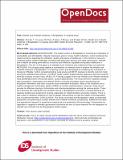| dc.contributor.author | Ahmed, Tanvir | |
| dc.contributor.author | Lucas, Henry | |
| dc.contributor.author | Khan, Azfar Sadun | |
| dc.contributor.author | Islam, Rubana | |
| dc.contributor.author | Bhuiya, Abbas | |
| dc.contributor.author | Iqbal, Mohammad | |
| dc.coverage.spatial | Bangladesh | en_GB |
| dc.date.accessioned | 2014-12-10T11:55:19Z | |
| dc.date.available | 2014-12-10T11:55:19Z | |
| dc.date.issued | 2014-06-16 | |
| dc.identifier.citation | Ahmed, T, H Lucas, AS Khan, R Islam, A Bhuiya, and M Iqbal (2014) eHealth and mHealth initiatives in Bangladesh: A scoping study BMC Health Services Research , 14:260 doi:10.1186/1472-6963-14-260 | en_GB |
| dc.identifier.issn | 1472-6963 | |
| dc.identifier.uri | https://opendocs.ids.ac.uk/opendocs/handle/20.500.12413/5422 | |
| dc.description.abstract | BACKGROUND: The health system of Bangladesh is haunted by challenges of accessibility and affordability. Despite impressive gains in many health indicators, recent evidence has raised concerns regarding the utilization, quality and equity of healthcare. In the context of new and unfamiliar public health challenges including high population density and rapid urbanization, eHealth and mHealth are being promoted as a route to cost-effective, equitable and quality healthcare in Bangladesh. The aim of this paper is to highlight such initiatives and understand their true potential.
METHODS: This scoping study applies a combination of research tools to explore 26 eHealth and mHealth initiatives in Bangladesh. A screening matrix was developed by modifying the framework of Arksey & O’Malley, further complemented by case study and SWOT analysis to identify common traits among the selected interventions. The WHO health system building blocks approach was then used for thematic analysis of these traits.
RESULTS: Findings suggest that most eHealth and mHealth initiatives have proliferated within the private sector, using mobile phones. The most common initiatives include tele-consultation, prescription and referral. While a minority of projects have a monitoring and evaluation framework, less than a quarter have undertaken evaluation. Most of the initiatives use a health management information system (HMIS) to monitor implementation. However, these do not provide for effective sharing of information and interconnectedness among the various actors. There are extremely few individuals with eHealth training in Bangladesh and there is a strong demand for capacity building and experience sharing, especially for implementation and policy making. There is also a lack of research evidence on how to design interventions to meet the needs of the population and on potential benefits.
CONCLUSION: This study concludes that Bangladesh needs considerable preparation and planning to sustain eHealth and mHealth initiatives successfully. Additional formative and operational research is essential to explore the true potential of the technology. Frameworks for regulation in regards to eHealth governance should be the aim of future research on the integration of eHealth and mHealth into the Bangladesh health system. | en_GB |
| dc.description.sponsorship | DFID | en_GB |
| dc.language.iso | en | en_GB |
| dc.publisher | Springer | en_GB |
| dc.rights.uri | http://creativecommons.org/licenses/by/2.0/ | en_GB |
| dc.subject | Health | en_GB |
| dc.subject | Technology | en_GB |
| dc.title | eHealth and mHealth initiatives in Bangladesh: A scoping study | en_GB |
| dc.type | Article | en_GB |
| dc.rights.holder | © 2014 Ahmed et al.; licensee BioMed Central Ltd. | en_GB |
| dc.identifier.externaluri | http://www.biomedcentral.com/1472-6963/14/260 | en_GB |


